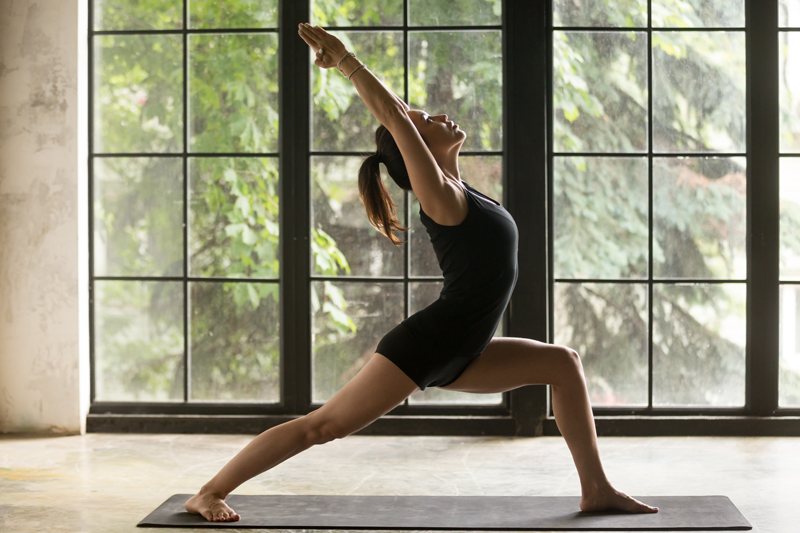When it comes to yoga, pre-natal classes are all the rage. But what happens once you’ve given birth to your little one? Though morning sickness and back pain may be a thing of the past, many new mums experience muscle tension, fatigue, and a whole host of other symptoms. Thankfully, yoga can provide the relief you’re searching for. Much like pre-natal classes, post-natal yoga classes are gentle and relaxing; additionally, the sessions address the common concerns of a post-natal body. In this article, we explore how to practice post-natal yoga. Before beginning, it’s important to pick up some comfortable yoga clothes. After giving birth, it’s common for your stomach to feel a little tender. With this in mind, getting your hands on some flexible yoga leggings is essential.
Bridge Pose
Working wonders for fatigue, Bridge Pose is popular amongst new mothers. As you perform the pose, your body gently compresses; when the stretch is released, fresh, oxygenate blood flushes through the body. To practice the asana, begin by laying on your back. Keeping the soles of your feet on the mat, slowly bend your knees. Keep your arms relaxed and let them rest by the sides of your body. Finally, bring your chin into your chest and lift your back and lower body off the mat to create a bridge. You are in Bridge Pose. Hold the posture for 13 seconds before lowering yourself back down to the floor.
Legs Up The Wall Pose
When your little one arrives, it’s likely that your sleeping pattern takes a hit. Interrupted sleep can onset a range of symptoms including tension, fatigue, and headaches. Legs Up The Wall Pose relieves these symptoms by allowing fresh blood to flow to the brain. To practice the asana, place the shortest side of your mat against a wall and take a seat. Next, lie back on your mat with your bottom touching the wall. Keeping your legs together, slowly extend them up the wall. In this asana, it doesn’t matter where your hands are. You can either rest them on your stomach or the mat – whichever you prefer! You are now in Legs Up The Wall Pose. Hold the asana for a few minutes whilst breathing deeply.
Cobra Pose
Helping to loosen the back and abdominal muscles, Cobra Pose is ideal for new mums. Additionally, the posture stimulates your digestive system and promotes better breathing. To practice the asana, begin by lying flat on your stomach. Keeping the tops of your feet on the floor, extend your legs out behind you. Next, place your hands directly underneath your shoulders with your palms touching the mat. Bring your elbows back into the body as you press your thighs into the floor. Stay in this position for a couple of breaths while your body gets ready for the final stage. When you’re ready, lift your chest off the floor by straightening your arms. Finally, press your lower body into the ground. You are in Cobra Pose. To stretch the spine even further, draw your shoulder blades up and back. Hold the pose for around 30 seconds before releasing the stretch.
Downward Dog
As well as strengthening your upper body, Downward Dog stretches your legs to increase mobility – ideal for those caring for a small child. To practice the asana, stand tall with your feet should-width apart. Hing-ing at the waist, lower your torso forward until your body forms a triangle. Your hands and feet should now both be on the ground. If your shoulders or hamstrings feel too tight for the pose, try bending your knees slightly to make the posture easier. Spreading your fingers for additional balance, move your head forward until it is in-between your upper arms. For maximum benefit, move your shoulders away from your ears. You are in Downward Dog. For a deeper stretch, try extending your tailbone up and back, breathing deeply whilst doing so. Hold the stretch for around 30 seconds, or until it becomes uncomfortable.
Wide-Legged Straddle
Strengthening the lower back, Wide-Legged Straddle is another popular pose amongst new mums. Addi-tionally, the posture stretches the hamstrings to increase mobility. To practice the asana, sit down on your mat with your legs apart. Once you’re comfortable, separate your legs as much as you can. Keeping your knees straight and toes pointing towards the ceiling, place your hands out in front of you. Next, slowly lower your upper body towards the mat. If necessary, rest your hands on the floor for support. Finally, ensure that your back is straight. You are now in Wide-Legged Straddle. Hold the asana for around 15 seconds before releasing the stretch and repeating the process. For best results, repeat 5 times.
In Summary
Whether you’re suffering from debilitating fatigue or extreme muscle tension, post-natal yoga can reduce your post-pregnancy symptoms. As well as offering various health benefits, post-natal yoga allows you to meet other new mums. Once you start a family, it can feel hard to relate to your single friends. Post-natal yoga allows you to meet new friends that understand exactly how you’re feeling. Better still, your little ones will be around the same age! This means that you can continue meeting for playdates as your children grow.
While post-natal yoga can be extremely beneficial, it’s important not to push your body too far. Most doctors recommend waiting 6 weeks before partaking in gentle exercise – especially if you’ve had a c-section or any complications. However, you understand your body better than anyone. If you feel ready, give post-natal yoga a try! As long as you’ve got a supportive yoga bra and a comfy mat, you should be good to go.

